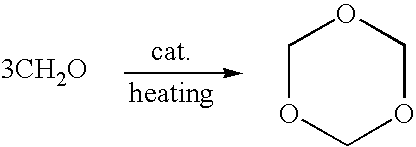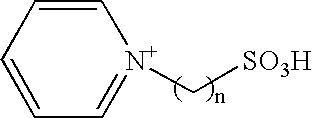Method of synthesizing trioxymethylene from formaldehyde by the catalytic action of an ionic liquid
a technology of ionic liquid and trioxymethylene, which is applied in the direction of organic chemistry, etc., can solve the problems of high device requirements, large amount of by-products, and high cost of the method,
- Summary
- Abstract
- Description
- Claims
- Application Information
AI Technical Summary
Benefits of technology
Problems solved by technology
Method used
Image
Examples
example 1
[0025] 100 g of 50.1% formaldehyde solution (containing 1.7% of methanol) and 2.6 g of catalyst a were added sequentially into a 250 ml reactor. The reactants were heated and refluxed sufficiently for 2 h. Then, the reflux ratio was adjusted to R=2 to evaporate formaldehyde, trioxymethylene, and water azeotropic mixture off from the top of the reactor. At the same time, 50 g of 50.1% formaldehyde solution was added into the reactor with a feeding speed of 0.8 ml / min. The temperature of the bottom of the rectifying still is 96.5° C., and the temperature of the top of the tower is 92° C. After 3 hs' reaction, chromatographic analysis result indicates the resultant distillate contains 21.5% of trioxymethylene, 2.1% of methanol, and 1.3% of methylal.
example 2
[0026] The same as in example 1, except 1.0 g of catalyst b was added into 110 g of 51.2% formaldehyde solution (containing 1.5% of methanol). The temperature of the bottom of the rectifying still is 96˜97° C., and the temperature of the top of the tower is 94° C. Chromatographic analysis result indicates the resultant distillate contains 24.9% of trioxymethylene, 2.0% of methanol, and 0.8% of methylal.
example 3
[0027] The same as in example 1, except 3.0 g of catalyst c was added into 100 g of 50.3% formaldehyde solution (containing 1.7% of methanol). The temperature of the bottom of the rectifying still is 96° C., and the temperature of the top of the tower is 94° C. Chromatographic analysis result indicates the resultant distillate contains 17.8% of trioxymethylene, 2.5% of methanol, and 1.6% of methylal.
PUM
| Property | Measurement | Unit |
|---|---|---|
| temperature | aaaaa | aaaaa |
| temperature | aaaaa | aaaaa |
| inner diameter | aaaaa | aaaaa |
Abstract
Description
Claims
Application Information
 Login to View More
Login to View More - R&D
- Intellectual Property
- Life Sciences
- Materials
- Tech Scout
- Unparalleled Data Quality
- Higher Quality Content
- 60% Fewer Hallucinations
Browse by: Latest US Patents, China's latest patents, Technical Efficacy Thesaurus, Application Domain, Technology Topic, Popular Technical Reports.
© 2025 PatSnap. All rights reserved.Legal|Privacy policy|Modern Slavery Act Transparency Statement|Sitemap|About US| Contact US: help@patsnap.com



